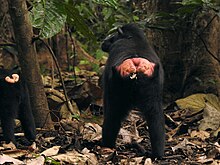
A callosity is a type of callus, a piece of skin that has become thickened as a result of repeated contact and friction.
Primates

All Old World monkeys, gibbons, and some chimpanzees have pads on their rears known as ischial callosities. The pads enable the monkeys to sleep sitting upright on thin branches, beyond reach of predators, without falling. Humans do not possess ischial callosities due to the gluteal muscles being large enough to provide the same cushioning.
The ischial callosities are one of the most distinctive pelvic features which separates Old World monkeys from New World monkeys.
Right whales

In whales, callosities are rough, calcified skin patches found on the heads of the three species of right whales. Callosities are a characteristic feature of the whale genus Eubalaena. Because they are found on the head of the whale and appear white against the dark background of the whale's skin, they allow the reliable identification of individuals of the species.
The callosities themselves are grey, but their white appearance is due to large colonies of whale lice, whale barnacles and parasitic worms which reside on them. Young whales and diseased individuals are often infested with a different species of cyamid, which gives the callosities on those whales an orange hue rather than white. Callosities arise naturally and are present even in late-term whale fetuses, although the work of lice digging into the surface of the skin may make them more jagged and hard over time.
Callosities are found on the upper surface of the whale's head: above the eyes, on the jawline and chin, and surrounding the blowholes. Callosities form a unique pattern on every right whale and, although callosities which are overgrown break off, the patterns do not change over a lifetime.
The evolutionary significance of callosities is unknown. Male right whales have a higher density of callosities than females. Males have been observed scratching one another with their callosities and it has been suggested by Payne & Dorsey (1983) that they are a sexually dimorphic feature, used for intra-specific sexual aggression. That explanation is not entirely satisfactory, because it does not account for the appearance of callosities in females. It has also been proposed that the barnacles attached to callosities are important in helping fend off attacks by orcas.
See also
Notes
- "Ischial callosities". MonkeyBuiznezz. Retrieved 2014-02-12.
- Fleagle, John G. (2013). Primate adaptation and evolution (3rd ed.). Amsterdam: Elsevier/Academic Press. ISBN 9780123786326. OCLC 820107187.
- Montagu, Ashley (1966-10-03). "The Buttocks and Natural Selection". JAMA. 198 (1): 51. doi:10.1001/jama.1966.03110140101027. ISSN 0098-7484. PMID 5953162.
- Steudel (1981), p 399
- ^ "Callosities". New England Aquarium. Archived from the original on 2014-11-22. Retrieved 24 August 2014.
- Ward, Paul (2001). "Right whales". Cool Antarctica. Retrieved 24 August 2014.
- ^ "Right Whale Research". Center for Coastal Studies, Provincetown, MA. Retrieved 24 August 2014.
- Payne, Roger; Dorsey, Eleanor M. (1983). "Sexual dimorphism and aggressive use of callosities in right whales (Eubalaena australis)". Communication and Behaviour of Whales (PDF). pp. 295–329. Retrieved 24 August 2014.
- Hayashi, Ryota. "Past biodiversity: Historical Japanese illustrations document the distribution of whales and their epibiotic barnacles" (PDF). University of Tokyo. Archived from the original on 2016-02-14. Retrieved 2021-06-28.
References
- Steudel, K (1981). "Functional Aspects of Primate Pelvic Structure: A Multivariate Approach" (PDF). American Journal of Physical Anthropology. 55 (3): 399–410. doi:10.1002/ajpa.1330550314. PMID 6791507. Archived from the original (PDF) on 2010-06-10. Retrieved 2009-07-19.
- Callosities by Mason T. Weinrich in the Encyclopedia of Marine Mammals. ISBN 0-12-551340-2.
- A Dictionary of Zoology 1999, Oxford University Press 1999
- "On Butts and Baboons". Artsibasheva, A. http://monkeybuiznezz.wordpress.com/2012/09/27/on-butts-and-baboons/